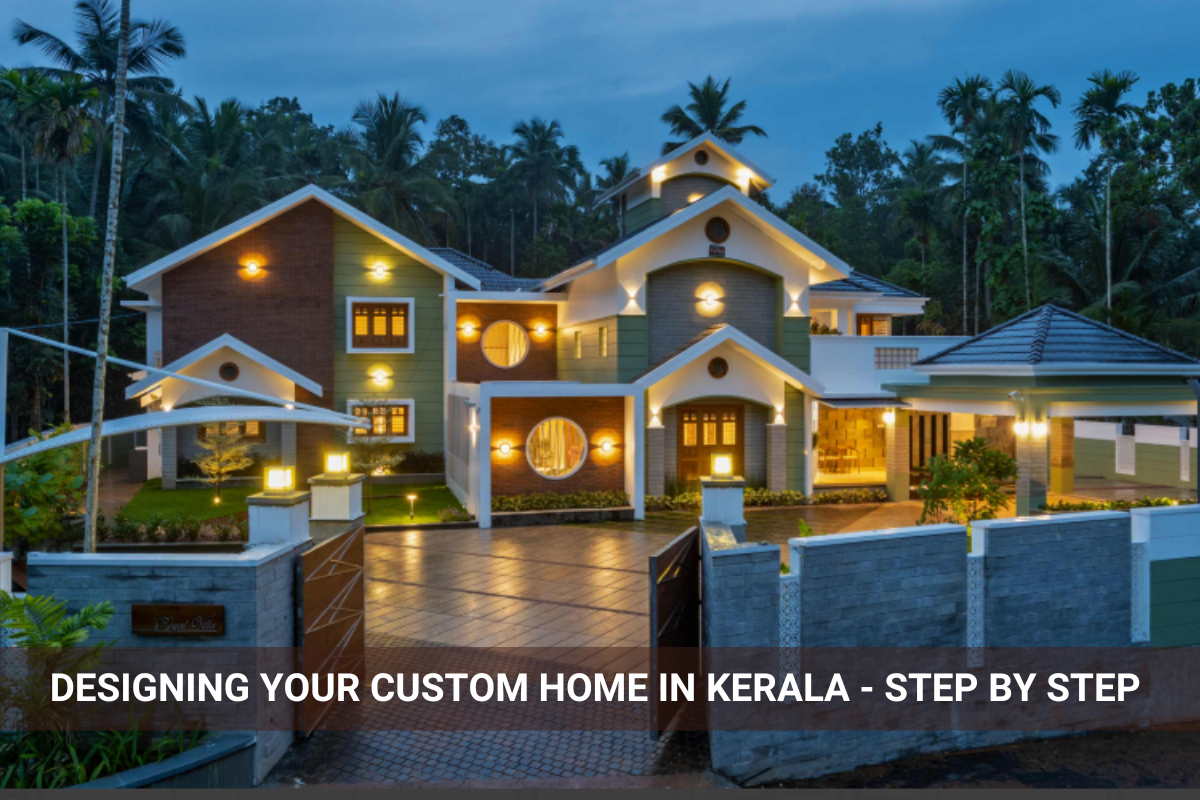Building a custom home is one of life’s most exciting and rewarding experiences. It's an opportunity to create a space that reflects your personality, lifestyle, and dreams. However, the process of designing and constructing a home can be complex, especially in a place as unique as Kerala. From the tropical climate and uneven terrain to the rich cultural heritage, designing a custom home in Kerala requires thoughtful planning and a deep understanding of local architecture.
This step-by-step guide will help you navigate the process, ensuring your dream home becomes a reality, all while staying within budget.
1. Initial Consultation: Understanding Your Vision and Needs
The journey begins with a consultation with an experienced architect. This is one of the most crucial steps in the process. The architect will help you clarify your vision for the home and understand your needs.
What Happens During the Consultation?
- ● Understanding Your Lifestyle: The architect will take the time to understand your family dynamics, daily routines, and long-term goals. Do you need extra rooms for a growing family? Are you considering a home office? Maybe you want spaces for entertainment or a dedicated area for yoga or meditation? These preferences shape the design.
- ● Identifying the Site’s Potential and Challenges: Kerala is known for its lush landscapes, but it also has a variety of terrains—hillsides, coastal areas, and even paddy fields. Your architect will evaluate the location’s unique features and challenges. The uneven terrain can affect the foundation, drainage, and overall design.
Why This Step Matters:
- ● Personalized Design: The architect’s job is to interpret your ideas and create a design that suits your specific requirements and desires.
- ● Local Knowledge: An architect familiar with Kerala's terrain and climate will offer valuable insights into optimizing the site’s potential, ensuring your home functions efficiently, even in challenging landscapes.
2. Budget Planning: Setting Realistic Expectations
Setting a realistic budget is vital for any renovation or new construction project, but especially for a custom home. Custom designs can vary widely in cost depending on the materials, complexity of the design, and site-specific challenges.
Key Considerations in Budgeting:
- ● Site Preparation Costs: Kerala’s terrain can be challenging. Building on a hillside or sloped land may require additional excavation and retaining walls, impacting the budget. An architect with experience in Kerala will help you estimate these costs accurately.
- ● Material Selection: Local materials, such as laterite stone, teakwood, and terracotta tiles, are commonly used in Kerala and can be cost-effective while adding aesthetic value. However, opting for premium materials like marble or granite will drive costs up.
- ● Labor and Contractors: The architect can guide you in hiring trusted local contractors, which can save you costs and time. Local experts are familiar with the specific demands of building in Kerala's environment.
Why This Step Matters:
- ● Avoiding Financial Surprises: Proper budgeting from the beginning helps avoid sudden expenses that can derail your project.
- ● Realistic Timeline: Budgeting isn’t just about money; it also influences the project timeline. Overbudgeting can lead to delays due to lack of funds, while under-budgeting can lead to rushed, subpar work.
3. Design Development: Bringing Your Dream to Life
Once the vision and budget are aligned, the architect moves forward with creating a design plan. This is where your dream starts to take shape.
What Happens During Design Development:
- ● Conceptualization: The architect develops a concept based on your preferences, the site’s layout, and Kerala’s architectural nuances. You’ll see rough sketches and 3D models of how the space will look.
- ● Planning for Kerala’s Climate: Kerala’s humid tropical climate calls for specific design elements like large windows for cross-ventilation, wide verandahs for shade, and sloped roofs to handle heavy rainfall. Your architect will incorporate these into the design.
- ● Integrating Traditional and Modern Elements: Many homeowners in Kerala appreciate a fusion of traditional and contemporary design elements. For example, a Nalukettu-inspired layout (traditional Kerala-style house) combined with modern interiors and sustainable energy solutions.
Why This Step Matters:
- ● Local Expertise in Design: An architect familiar with Kerala’s history and style will incorporate local architecture like teakwood paneling, intricate carvings, and open courtyards that fit your personal style and the environment.
- ● Energy Efficiency: Proper design can significantly reduce your energy consumption. Your architect will design the home to take advantage of natural cooling and rainwater harvesting.
4. Landscaping: Enhancing Your Home with Nature
One of the most significant challenges in Kerala is its varied terrain. With its sloping hills, coastal plains, and dense greenery, landscaping is not just an aesthetic choice but a critical element in your home’s design.
Key Landscaping Elements in Kerala:
- ● Terracing and Erosion Control: If your home is located on a hillside, terraces are essential to prevent soil erosion. Your architect may design step-like terraces with local plants to stabilize the land and make the space usable.
- ● Utilizing Local Flora: Kerala is home to a rich variety of flora, including coconut palms, banana trees, and frangipani. Incorporating these local plants into your garden not only blends the home into its surroundings but also ensures that your landscaping is sustainable.
- ● Water Features: Incorporating ponds, streams, or fountains inspired by Kerala’s traditional Naduvazhi architecture can add tranquility and beauty to the space, especially in homes near water bodies.
Why This Step Matters:
- ● Maximizing Space: Kerala’s uneven terrain can make traditional landscaping difficult. Proper landscape design helps in maximizing the usable space around your home while protecting it from landslides or erosion.
- ● Natural Cooling: Well-placed trees, shrubs, and water features can significantly cool the environment and reduce the need for air conditioning, which is important in Kerala’s hot climate.
5. Finalizing and Approving the Design: Ensuring Legal and Practical Compliance
Before breaking ground, the design must go through several regulatory and legal checks.
What Happens in This Step:
- ● Building Code and Permits: Kerala has strict building regulations that must be adhered to. Your architect will ensure your design complies with local codes and secure the necessary permits for construction.
- ● Finalizing Details: This is where you and your architect will finalize all design details, including room sizes, layout, materials, and the type of finishings you prefer.
Why This Step Matters:
- ● Avoiding Legal Issues: Failing to comply with building codes can lead to delays, fines, or even demolition orders.
- ● Ensuring Functionality: Finalizing the design ensures that the home will function as intended—whether it’s for your family’s growing needs or for long-term sustainability.
6. Construction: Bringing the Design to Life
With everything in place, construction begins. Your architect will oversee the building process, ensuring that the project stays on track, within budget, and true to the design vision.
Key Responsibilities During Construction:
- ● Quality Control: Your architect ensures that the construction quality aligns with the design plan. They will inspect materials and workmanship regularly.
- ● Timely Execution: The architect coordinates with contractors and vendors, managing timelines and keeping the project moving forward.
- ● Client Communication: Regular updates ensure you are informed and involved in the progress, avoiding any surprises.
Why This Step Matters:
- ● On-Time Delivery: An architect ensures that delays are minimized, and the project is completed as per the agreed schedule.
- ● Ensuring Design Integrity: Their expertise ensures that the final product reflects your vision, even with inevitable changes during construction.
Conclusion: Creating Your Dream Home in Kerala
Building a custom home in Kerala is an exciting endeavor, but it requires careful planning, expertise, and local knowledge. Consulting an architect ensures that the design process is efficient, cost-effective, and customized to your needs. From initial consultation to construction, your architect will guide you through every phase, ensuring that your home not only meets but exceeds your expectations.
By leveraging the unique beauty of Kerala’s landscapes, climate, and cultural heritage, you can create a home that is both a personal sanctuary and a lasting investment. Don’t navigate this journey alone—partner with a skilled architect and bring your dream home to life.


